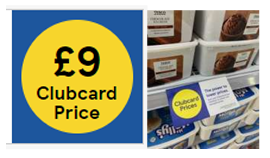The High Court of England and Wales yesterday (19 April 2023) held that Tesco has been infringing Lidl’s trade mark and copyright, as well as passing off, through their ‘Clubcard Prices’ campaign.
A minor victory for Tesco – their successful counterclaim for invalidity based on bad faith in respect of one of Lidl’s marks – was not enough to turn the tide in their favour.
In her lengthy judgement, which ran to 102 pages, Mrs Justice Joanna Smith found in favour of Lidl on most grounds, including that Tesco was taking unfair advantage of the reputation of Lidl’s mark and causing damage to its distinctive character through dilution.
The background
The parties in this case require little introduction.
Lidl is a German supermarket business established in 1973 which opened its first store in the UK in 1994. Their logo consists of the stylised word LIDL inside a yellow circle with a red inner ring, which is itself inside a blue square. In the judgement this is referred to as “the Mark with Text”.
Lidl also owns registrations for the same mark without the word LIDL, known as “the Wordless Mark”. The Mark With Text appears throughout Lidl’s stores, on their advertising and on their products; it was common ground that the Wordless Mark had not been used in its exact registered form.

Tesco is a UK supermarket giant, which can trace its history back to a market stall in the East End of London in 1919. As the single biggest supermarket operator in the UK, Tesco had in the region of 26% of the UK market share in 2022.
Since 1995 Tesco has operated its Clubcard scheme – a loyalty scheme to reward customers for shopping at Tesco. The Clubcard Prices promotion, which formed the basis of these proceedings, is a discrete advertising strategy which launched in September 2020. In this promotion, Tesco uses a sign consisting of a yellow circle inside a blue square with text inside the circle, usually ‘Clubcard Prices’, sometimes including a price (“the CCP Signs”).

The market
Evidence presented to the Court showed a growth in Lidl’s position within the UK market over recent years, from around 3.5% share in 2015 to 7.2% in 2022. Lidl claimed to have worked hard to reframe the public perception of “discounter” supermarkets through campaigns like “Big on Quality, Lidl on price” which launched at the beginning of 2017. By the time it started working on its Clubcard Prices promotion, Tesco was well aware of Lidl’s gains in positioning itself as offering good value at low prices.
The scheme launched in September 2020. The CCP Signs were used widely in print media, on Tesco’s website, on social media channels, at so called out of home locations (“OOH”) such as bus stops and on television. One particular television advert showed a woman in a supermarket ‘zapping’ around her Clubcard and bringing down prices as she did so. Every time she ‘zapped’; a new lower price appeared in a CCP Sign. The CCP Signs were also used extensively in Tesco stores.

Trade mark infringement – the mark with text
Lidl’s claim for trade mark infringement was based on the reputation of its mark. Tesco accepted that the Mark with Text is distinctive and has a reputation in the UK for retail services.
Joanna Smith J found that the CCP Signs were similar to the Mark with Text, and that the public would establish a link between the two.
“The visual similarity is here the significant feature and, whilst I accept that the text represents an important point of difference, nonetheless I do not consider that it has the effect of extinguishing the strong impression of similarity conveyed by their backgrounds in the form of the yellow circle, sitting in the middle of the blue square”.
There was notable evidence that members of Tesco’s internal team had identified the similarity between the signs and the danger of confusion during the development phase of the CCP Signs. The Court heard oral evidence from two members of the general public who had seen the CCP Signs and thought they were “uncannily similar to the Lidl logo” and “blatant mimicry”. There was also evidence of actual confusion arising. For example, in a survey commissioned by Tesco to evaluate the Clubcard Prices promotion in November 2020, 8% of the 276 customers who saw the OOH advert thought it was for Lidl.
Joanna Smith J further found that Lidl had done enough to establish both unfair advantage, and detriment to the distinctive character of the Mark with Text, which was primarily evidenced by the fact that it had found it necessary to take evasive action in the form of corrective advertising. Lidl’s claim for trade mark infringement therefore succeeded.
Trade mark infringement, revocation and invalidity – the wordless mark
She then went on to consider the trade mark infringement claim in respect of the Wordless Mark, along with Tesco’s counterclaim for invalidity and revocation on the grounds of non-use.
She concluded that, if the mark was validly registered, it would have been infringed. She was persuaded that the use of the Mark with Text was sufficient to establish genuine use of the Wordless Mark. She also noted survey evidence that the mark was perceived by a significant proportion of relevant consumers as indicating the origin of Lidl’s goods and services. In particular, there was a YouGov survey in which participants were shown the Wordless Mark and asked “please take a look at the image below before answering the question that follows. ‘What do you think this image is?’ 73% of responses mentioned Lidl alone, while another 2.3% mentioned Lidl with another brand.
However, Tesco also alleged that each of the registrations for the Wordless Mark had been applied for in bad faith. They stated there was no bona fide intention to use the Wordless Mark in the form as registered. They also accused Lidl of evergreening, referring to an attempt to maintain a monopoly in a trade mark by refiling in order to circumvent use requirements.
Joanna Smith J agreed with Tesco’s arguments about the intentions behind Lidl’s first application for the Wordless Mark, dating from 1995, finding it invalid. Whilst she considered the mark was now in use, as part of the Mark with Text, it was not Lidl’s intention to use it when they filed the application – it was merely intended to be “a legal weapon”.
She further found that other registrations from 2002, 2005 and 2007 were designed in part to evergreen so as to avoid sanctions for non-use. As a result, she held they were invalid for having been filed in bad faith.
Tesco had identified a further application filed by Lidl for the Wordless Mark in 2021 and argued that this was another example of evergreening. However, in that case Joanna Smith J accepted Lidl’s plea that the application was designed to achieve protection for a version of the mark that reflected the recent brand-colour update and in relation to a broader specification of goods and services, including those which the Lidl business had begun to sell in the intervening time since 2007. She further noted that, by this point, it was reasonable to find that Lidl genuinely believed that the Wordless Mark had been the subject of genuine use.
Passing off
Lidl argued that Tesco had misrepresented that products sold by Tesco share the qualities of those of Lidl, being of good standard and sold at the same or equivalent price as those in other supermarkets.
Joanna Smith J accepted Lidl’s goodwill, including its reputation as a discounter that offers goods at low prices. On the other hand, she agreed with Tesco that Lidl’s claim that consumers associate Lidl with “quality” is both vague and lacking in evidential support.
Nevertheless, overall she found that a substantial number of consumers have been deceived and that Lidl has suffered damage as a result. Passing off was therefore established.
Copyright infringement
Lidl also alleged that Tesco was infringing the copyright in its marks. The decision focused on the Mark with Text, since Joanna Smith J agreed with Tesco’s submission that, where the Wordless Mark had not in practice been used, other than as a background to the Mark with Text, any copying could only have been in respect of the Mark with Text.
The creation of the Mark with Text was a staged process. The stylised Lidl text was designed in around 1972/73. Around the beginning of the 1980s, a circular logo was created in the form of a yellow circle with a red border, with the Lidl stylised text superimposed on it. It wasn’t until the late 1980s that the square version of the Lidl logo was created, forming the Mark with Text. Lidl said that the Mark with Text was first published in 1987.
Tesco argued that the Mark with Text could not qualify for copyright protection because it was not an original work. However, Joanna Smith J held that sufficient time, labour and creative freedom was involved in Lidl taking the Lidl text and the yellow circle with the red border and superimposing them on a blue background to create the Mark with Text. Whilst the artistic quality involved was not “high”, the work was nonetheless original.
As for whether the work had been copied, Joanna Smith J was critical of the inconsistent evidence from one of Tesco’s witnesses, which appeared to have been designed to obscure the involvement of an external design agency. She found that the design agency copied the background to the Lidl logo as part of its work and that, as a result, Tesco had infringed when it adopted the sign.
Conclusions
It might initially seem surprising that trade mark infringement has been found based on similar background figurative elements, where the text is entirely different. However, the reputation of Lidl’s mark and the fact that both parties operate in the same field of business both contribute to this. The evidence of actual confusion is also highly persuasive and cannot be ignored.
There was an interesting discussion and application of the principles in Specsavers regarding use of figurative elements as part of a composite mark. The key is ultimately how a consumer perceives the mark. In this case, Joanna Smith J held that the evidence shows that consumers have understood the Wordless Mark element of the Mark with Text as distinctive of Lidl and indicating the origin of their goods and services, not merely as a decorative background.
Regarding bad faith, the decision reminds us that the applicant’s intention at the time of filing is key; filing in bad faith cannot be ‘cured’ by later finding yourself using the mark. It is also a further ‘nail in the coffin’ of the practice of evergreening.
On the face of it, the decision would mark the end of the Tesco Clubcard Prices campaign in its current form. However, Tesco has already declared it will seek leave to appeal. Watch this space!
Rebecca is a Partner and Chartered Trade Mark Attorney at Mewburn Ellis. She handles all aspects of trade mark work, with a particular focus on managing large trade mark portfolios, devising international filing and enforcement strategies, and negotiating settlements in trade mark disputes. Rebecca has extensive experience of trade mark opposition, revocation and invalidity proceedings before the UK Intellectual Property Office (UKIPO), including very complex evidence based cases. Rebecca also has a strong track record in overcoming objections raised to trade mark applications.
Email: rebecca.anderson@mewburn.com

-1.png)
